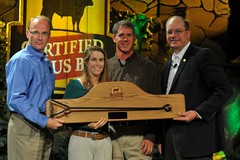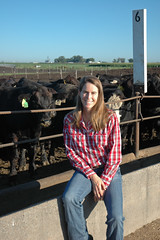Eric Schlosser wrote Fast Food Nation in 2001, four years after Matt and I moved to Nebraska to go to work on the family farm. I had heard of Mr. Schlosser because of his participation in the filming of the movie Food, Inc. but I had never read his book until a couple of weeks ago.
Sometimes the only way you can take a really good look at yourself is through somebody else’s eyes.
I read Fast Food Nation because a group of high school students from Omaha asked me to. They read the book as part of a class requirement and were looking for another point of view. The book focuses on food production practices and cultural eating changes relative to the growth of fast food restaurant chains. Beef production, in particular packing plants and feed yards, appear as a center stage topic.
I felt a myriad of emotions as I read Schlosser’s words. While I agreed with his desire to promote good health through a balanced diet and physical fitness, the beef industry that he described in the book was not the one that I participate in.
When I look out my window, I see something very different from what the author describes. I see my feed yard as a place of integrity, where cattle are well cared for and enabled to make safe and healthy beef. My husband and I also work hard to be environmental stewards using a combination of crop farm and cattle farm to create a sustainable and productive cycle.
While touring the major beef packing plants intermittently during my 16 years as a cattle farmer, I also saw something very different from what the author describes. I toured Swift (JBS) in 1998, Cargill in 2001, National Beef in 2012, and Tyson just two weeks ago. I believe that these packing plants are well run.
In fact, they are all audited on animal welfare, sanitation and food safety practices to ensure quality and professionalism. Most of them have Temple Grandin’s proposed camera surveillance system to ensure constant compliance in addition to third party auditing on animal welfare standards. Additionally, all of them have USDA and FSIS (Food Safety Inspection Service) inspectors in the plants anytime that they are operational to protect for food safety assurance.
As I think about the book, this quote from James Thurber keeps circulating through my head:
There are two kinds of light – the glow that illuminates and the glare that obscures.
It is my hope that my Feed Yard Foodie blog is the light that illuminates—showing each of you how I raise cattle and grow the beef that you purchase to feed your families.
It is my opinion that Fast Food Nation is a glare created by a predisposed elitist— obscuring the U.S. beef production system in order to fit a desired hypothesis. No where in the book can I find a cattle farm like mine or a balanced description of a packing plant. For a more extensive book commentary and links to additional literature, please click fast-food-nation-thoughts-for-the-blog-with-links1
I would like to thank the three classes of students (along with their teacher) from Omaha for reaching out to me and inspiring me to read another point of view relative to the industry that I have grown to love. Looking through someone else’s eyes is a great intellectual exercise and allows me continual personal growth and improvement.
Interestingly enough, the students from Omaha decided that Mr. Schlosser would like my feed yard. They likened it to the In and Out Burger restaurants that the author endorsed at the end of the book.
What do you all think?












Had you ever been around or worked with live stock before the feed lot? You seem so at ease and relaxed in the feed lot.
Hi Ellie,
No, I had never worked with livestock prior to meeting my husband. The closest that I had ever gotten to cattle before meeting Matt was looking at them across the pasture while hunting with my dad on a ranch in Central Florida where he paid to have hunting rights.
I am incredibly at ease around them–I love to handle and train cattle. It is my favorite part of what I do everyday. The psychology of animals fascinates me, and I love the peace and quiet that goes along with good cattle handling.
There was certainly a transition time while I was learning to understand them and getting used to handling animals that were 13X the size of me (I actually talk about that in the podcast that I did with John that came up last week). But today, it is something that I am completely at ease with and truly a favorite part of each day.
It’s great to hear from you! Thanks for continuing to read and follow.
Anne
Another great post 🙂 I think all the time how much people believe just because someone writes a book and says it is so. Insted we need to be better about reasearching what is written and find out the truth, before taking someones oppenion as fact. I am so glad you were able to point this out to some students and gave them a heads up in their future to not just believe something because it is in print. I have read some of that book and just coudn’t finish it from my memory as it made me upset as I know some of what you said about how many people are out there like you that have GREAT animal care 🙂 Keep up the good work 🙂
Thank you! There were times that the book was very difficult for me to keep reading–for the very reason that you state. But, I had given the kids my word that I would read it so I kept plowing through. I wrote quite a lengthy set of notes to send to them (as you probably saw when you clicked on the link)–the kids all marveled at how much I had written, but I needed to get my thoughts out to help me internalize both the book and the way that it made me feel.
Thanks for reading and supporting me!
Anne
I remember seeing a poster at the University of Illinois in the 70’s showing the nutrition provided by a burger (with pickles, lettuce and tomato), fries and shake. It was a significant portion of diet, not just in calories, but also protein and essential vitamins. But it was a long way from a complete diet. MacDonald’s happy meal (the favorite example of food nazi’s), is much better due to substituting chocolate milk for the shake (with ice cream) and better yet if carrot sticks or an apple are substituted for the french fires. But it is easy to find sponsored or featured opinions in mainstream enews that an organic deep fat fried potato chip is better for you than a happy meal. If one balances for protein, it takes about 8000 calories worth (or an Eskimos daily winter time diet of blubber to keep warm) to match a little happy meal. Fast foods tend not to be close to a complete diet, but they are also similar in many ways to more respected food choices and certainly not something to be demonized in the ways they have been.
Other things I remember.
Once upon a time, bone meal and rendered fats and proteins were considered acceptable feed additives. That changed quickly when it was recognized that cooking did not kiil some diseases in the BSE class The North American ban was so fast and so well followed that only one BSE case transmitted from feeds was found in the USA and just a handful in Canada. The Japanese did not react as fast and relied more on imported feedstuffs and as a consequence had enough BSE cases that the Japanese people thought meat had to be tested to be safe. So Mr. Schlosser was right about the BSE thing, just not in North America. And the yuck factor just wasn’t there.
Many years ago, some feedlots and some universities experimented with manure as a feed supplement. There is a bit of sanity to the idea. We place corn and water in a vat and the yeasts produce alcohol and a high protein, nutirent dense coproduct. We place corn and water in a rumen, antd the bacteria feed the host a produce a nutrient dense product we call manure. In addition to the yuck factor and the biosecurity factor, it did not work well enough. So once again, Mr. Schlosser has an example to cite, it just not even a rare practice, let alone the norm he expects the reader to believe.
Who was it said, that in everyrreally big lie, there is a bit of truth?
Rex,
Figuring out the science of good care and nutrition is an ongoing task–as you know, it is something that folks involved in beef production are constantly trying to improve. I am not familiar with the studies that you are talking about here relative to manure, but it is likely that they occurred before I showed up in Nebraska in 1997.
As I responded to the kids, I tried to speak from my own personal experience. I did put in a few links so that they could further research some of the items if they desired. I think that the most important part of my interaction with the students was the fact that I gave them a personal story to identify with—they also spent some time on the blog site “getting to know me better” which I think was very beneficial when we starting sending notes back and forth about the book.
All in all, it was a great experience for me.
Anne
Pingback: Why I Occupy My Food Supply | Agriculture Proud
Reblogged this on A life of quality!.
Pingback: Farm Check: The Goal | Feed Yard Foodie
Ahhh. I found your notes and blog entry to use with my students this year. Thank you so much.
Pingback: The Lens of a Farmer… | Feed Yard Foodie
This is really attention-grabbing, You are
an overly professiona blogger. I’ve joied your rss feed and look
forward to in search of extra of your wonderful post.
Additionally, I have shared your website
iin myy social networks
Pingback: Fast Food Nation | Messages from Murphy